Crystal structure of tubulin tyrosine ligase-like 3 reveals essential architectural elements unique to tubulin monoglycylases
- PMID: 28576883
- PMCID: PMC5488916
- DOI: 10.1073/pnas.1617286114
Crystal structure of tubulin tyrosine ligase-like 3 reveals essential architectural elements unique to tubulin monoglycylases
Abstract
Glycylation and glutamylation, the posttranslational addition of glycines and glutamates to genetically encoded glutamates in the intrinsically disordered tubulin C-terminal tails, are crucial for the biogenesis and stability of cilia and flagella and play important roles in metazoan development. Members of the diverse family of tubulin tyrosine ligase-like (TTLL) enzymes catalyze these modifications, which are part of an evolutionarily conserved and complex tubulin code that regulates microtubule interactions with cellular effectors. The site specificity of TTLL enzymes and their biochemical interplay remain largely unknown. Here, we report an in vitro characterization of a tubulin glycylase. We show that TTLL3 glycylates the β-tubulin tail at four sites in a hierarchical order and that TTLL3 and the glutamylase TTLL7 compete for overlapping sites on the tubulin tail, providing a molecular basis for the anticorrelation between glutamylation and glycylation observed in axonemes. This anticorrelation demonstrates how a combinatorial tubulin code written in two different posttranslational modifications can arise through the activities of related but distinct TTLL enzymes. To elucidate what structural elements differentiate TTLL glycylases from glutamylases, with which they share the common TTL scaffold, we determined the TTLL3 X-ray structure at 2.3-Å resolution. This structure reveals two architectural elements unique to glycyl initiases and critical for their activity. Thus, our work sheds light on the structural and functional diversification of TTLL enzymes, and constitutes an initial important step toward understanding how the tubulin code is written through the intersection of activities of multiple TTLL enzymes.
Keywords: TTLL enzymes; glutamylation; glycylation; tubulin code; tubulin modification.
Conflict of interest statement
The authors declare no conflict of interest.
Figures
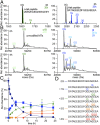
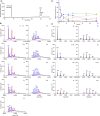


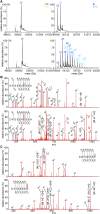

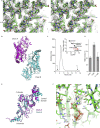
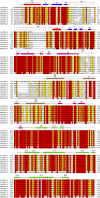


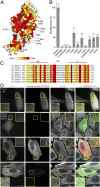

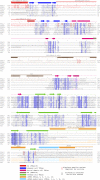
Similar articles
-
Tubulin tyrosine ligase-like genes ttll3 and ttll6 maintain zebrafish cilia structure and motility.J Biol Chem. 2011 Apr 1;286(13):11685-95. doi: 10.1074/jbc.M110.209817. Epub 2011 Jan 24. J Biol Chem. 2011. PMID: 21262966 Free PMC article.
-
Multivalent Microtubule Recognition by Tubulin Tyrosine Ligase-like Family Glutamylases.Cell. 2015 May 21;161(5):1112-1123. doi: 10.1016/j.cell.2015.04.003. Epub 2015 May 7. Cell. 2015. PMID: 25959773 Free PMC article.
-
Mutation of NEKL-4/NEK10 and TTLL genes suppress neuronal ciliary degeneration caused by loss of CCPP-1 deglutamylase function.PLoS Genet. 2020 Oct 16;16(10):e1009052. doi: 10.1371/journal.pgen.1009052. eCollection 2020 Oct. PLoS Genet. 2020. PMID: 33064774 Free PMC article.
-
Ciliary and flagellar structure and function--their regulations by posttranslational modifications of axonemal tubulin.Int Rev Cell Mol Biol. 2012;294:133-70. doi: 10.1016/B978-0-12-394305-7.00003-3. Int Rev Cell Mol Biol. 2012. PMID: 22364873 Review.
-
Writing and Reading the Tubulin Code.J Biol Chem. 2015 Jul 10;290(28):17163-72. doi: 10.1074/jbc.R115.637447. Epub 2015 May 8. J Biol Chem. 2015. PMID: 25957412 Free PMC article. Review.
Cited by
-
Tubulin code eraser CCP5 binds branch glutamates by substrate deformation.Nature. 2024 Jul;631(8022):905-912. doi: 10.1038/s41586-024-07699-0. Epub 2024 Jul 17. Nature. 2024. PMID: 39020174
-
Regulatory mechanisms of the dynein-2 motility by post-translational modification revealed by MD simulation.Sci Rep. 2023 Jan 26;13(1):1477. doi: 10.1038/s41598-023-28026-z. Sci Rep. 2023. PMID: 36702893 Free PMC article.
-
Frequent mutation of hypoxia-related genes in persistent pulmonary hypertension of the newborn.Respir Res. 2020 Feb 13;21(1):53. doi: 10.1186/s12931-020-1314-5. Respir Res. 2020. PMID: 32054482 Free PMC article.
-
Combinatorial and antagonistic effects of tubulin glutamylation and glycylation on katanin microtubule severing.Dev Cell. 2022 Nov 7;57(21):2497-2513.e6. doi: 10.1016/j.devcel.2022.10.003. Dev Cell. 2022. PMID: 36347241 Free PMC article.
-
The Tubulin Code in Microtubule Dynamics and Information Encoding.Dev Cell. 2020 Jul 6;54(1):7-20. doi: 10.1016/j.devcel.2020.06.008. Dev Cell. 2020. PMID: 32634400 Free PMC article. Review.
References
-
- Verhey KJ, Gaertig J. The tubulin code. Cell Cycle. 2007;6:2152–2160. - PubMed
Publication types
MeSH terms
Substances
LinkOut - more resources
Full Text Sources
Other Literature Sources
Molecular Biology Databases

